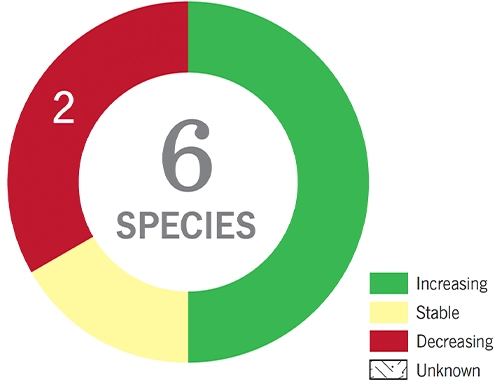This category encompasses habitats that are generally poorly vegetated and usually occur at higher elevations. Rocky habitats include cliffs, rocky ridgelines, and talus slopes (the latter rarely used by birds) in the northern and western parts of the state. Alpine habitats dominated by sedges and forbs occur above 4,900′ in the White Mountains. Very few species of birds occur in the alpine zone, and only the American Pipit occurs here as a breeding species.

Common Nighthawk
Peregrine Falcon
American Pipit
Turkey Vulture
Common Raven
Dark-eyed Junco
With only six species known to breed in this habitat, a broad summary of trends is not informative, especially since these six species use quite different sub-habitats.
It is often assumed that high-elevation alpine habitats will be among the first to feel the effects of a warming climate, and potentially get replaced by high-elevation spruce-fir. However, there is also evidence that the harsh climate in the Presidential Range will slow any such effects.
These habitats are fragile, with limited soil to support the growth of plants. A well-known risk to the alpine zone is vegetation trampling by hikers who go off-trail. Cliff-nesting Peregrine Falcons are sensitive to disturbance from rock climbers, and for this reason cliffs with active nests are closed each year during the breeding season.
Ensuring that the impacts of hikers and climbers are minimized is the key conservation action in these habitats. Ensuring that alpine habitats persist in the long term requires rapid and effective efforts to slow or mitigate climate change.
Although ongoing monitoring of Peregrine Falcons and recent studies of American Pipits allow us to assess the status of those two species, we lack data on Common Nighthawks in these habitats.
Many threats faced by birds are tied to the habitats where they breed. Explore the habitats and learn more about each one’s characteristics, population trends, threats, and conservation actions.
Information for the species profiles on this website was compiled from a combination of the sources listed below.
The Birds of New Hampshire. By Allan R. Keith and Robert B. Fox. 2013. Memoirs of the Nuttall Ornithological club No. 19.
Atlas of the Breeding Birds of New Hampshire. Carol R. Foss, ed. 1994. Arcadia Publishing Company and Audubon Society of New Hampshire
Birds of the World. Various authors and dates. Cornell Laboratory of Ornithology.
Data from the Breeding Bird Survey
Data from the Christmas Bird Count